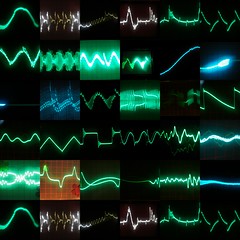Rolling Stone | The Death of High FidelityAh, you young people. You don't remember.
David Bendeth, a producer who works with rock bands like Hawthorne Heights and Paramore, knows that the albums he makes are often played through tiny computer speakers by fans who are busy surfing the Internet. So he's not surprised when record labels ask the mastering engineers who work on his CDs to crank up the sound levels so high that even the soft parts sound loud.
Over the past decade and a half, a revolution in recording technology has changed the way albums are produced, mixed and mastered — almost always for the worse. "They make it loud to get [listeners'] attention," Bendeth says. Engineers do that by applying dynamic range compression, which reduces the difference between the loudest and softest sounds in a song. Like many of his peers, Bendeth believes that relying too much on this effect can obscure sonic detail, rob music of its emotional power and leave listeners with what engineers call ear fatigue. "I think most everything is mastered a little too loud," Bendeth says. "The industry decided that it's a volume contest."
Producers and engineers call this "the loudness war," and it has changed the way almost every new pop and rock album sounds. But volume isn't the only issue. Computer programs like Pro Tools, which let audio engineers manipulate sound the way a word processor edits text, make musicians sound unnaturally perfect. And today's listeners consume an increasing amount of music on MP3, which eliminates much of the data from the original CD file and can leave music sounding tinny or hollow. "With all the technical innovation, music sounds worse," says Steely Dan's Donald Fagen, who has made what are considered some of the best-sounding records of all time. "God is in the details. But there are no details anymore."
Way back when FM radio first began to crawl out of its niche and into the mainstream, it sounded beautiful. Compared to the tinny crackle of AM, FM was clean, pure sound, with clear, dynamic highs and quiet lows -- and, almost unheard-of (so to speak) today, the occasional moment of true silence.
Today, I can't hear the difference between AM and FM. The sound I used to associate with FM one must now buy satellite radio to get. The conspicuous exception is public radio. I can't tell for sure if they are actually maintaining the same standards they always have, or have simply not drifted as far downwards, but compared to it, listening to other music stations is like being beaten with a blunt instrument.

1 comment:
I suspect that the hearing of many (possibly most) radio listeners is so bad, due to years of listening to music TOO DAMN LOUD, that they are unable to tell the difference.
RNB
Post a Comment